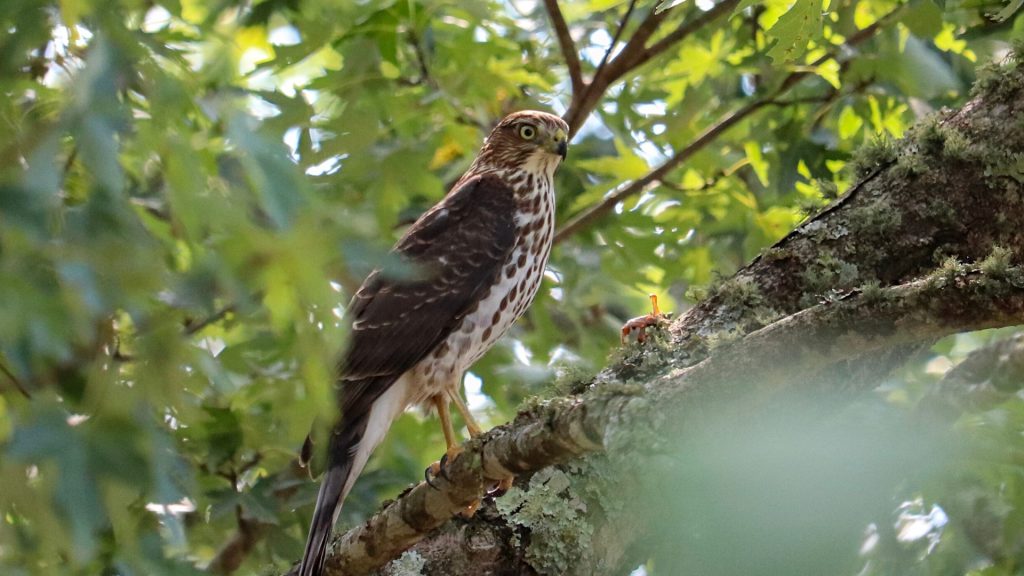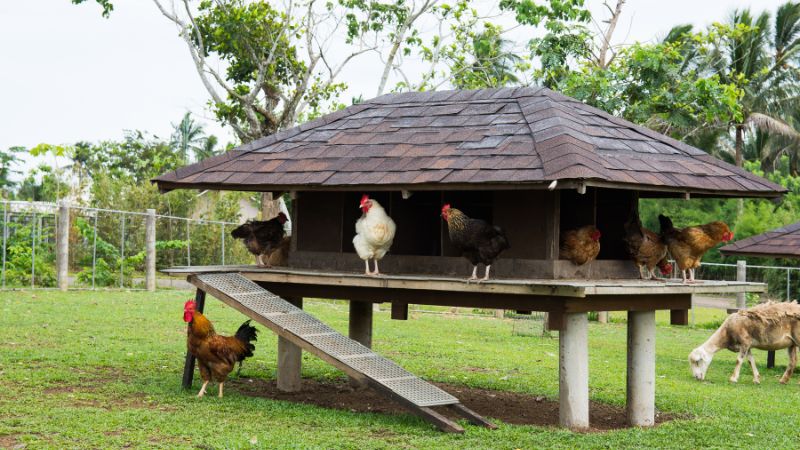Firstly, it’s important to know that hawks have been protected in the United States under the Federal Migratory Bird Treaty Act since 1918. This means that it is illegal to hunt, trap, cage, shoot, poison, or kill them. Doing so can result in imprisonment and heavy fines.
So, can you shoot a hawk if it is attacking chickens? You can shoot or kill a hawk only if you have a special permit from Wildlife Services. Additionally, shooting is authorized only in specific situations that involve public health and safety. Along with a permit, there are rules that you will have to adhere to before attempting to shoot a hawk.
With hawks, offenders can face imprisonment along with a heavy fine if they are killed without a permit. Nevertheless, hawks have proved to be a danger to poultry in the past, so let’s take a look at the best ways to resolve this problem. Let’s begin!
Why Can’t You Shoot a Hawk?

Hawks are considered as raptors or birds of prey. Raptors play an important role in balancing prey species in ecosystems. In the food pyramid, a hawk resides on the top as they are apex predators, while prey such as squirrels and chickens reside in the middle.
If the predatory species is removed from the top of the pyramid, world ecosystems would fall out of balance due to the overpopulation of the prey species. A prey species, if left unchecked, can “eat itself out of house and home,” as the habitat can only feed and support a limited number of animals.
This is why we have laws that protect predators like hawks and owls from being harmed. The laws are our way to protect the balance of the habitat. However, in certain scenarios, you can obtain a permit that will allow you to legally shoot a raptor such as a hawk.
How Can You Shoot Hawks Legally: Information
First and foremost, you will need to obtain a permit called the Federal Migratory Bird Depredation Permit. A permit can be obtained if there is depredation or loss caused by hawks. Depredation covers damages incurred on agriculture, private property, protected wildlife, and human health and safety.
Almost all birds (including their eggs and nests) that are native to the United States are protected under the Migratory Bird Treaty Act (MBTA). Additionally, the MBTA widened its scope in 1972 and protected certain international species like hawks and eagles as well.
Additionally, these permits are only intended to provide a short-term solution for bird damage until you find a long-term, non-lethal solution to prevent the birds from damaging your goods. This implies that you will have to find a better solution to prevent hawks from attacking your poultry in the long run.
How to Obtain a Permit to Shoot Hawks?

If you want to apply for a permit to shoot hawks that are inflicting damage to your property, you will need to fulfill the following three criteria:
- The applicant must be the one experiencing the damage.
- The applicant is responsible for compliance with the permit (We will elaborate on the rules in the later section)
- The applicant must have the authority to implement non-lethal measures in the near future.
In order to obtain an application form for the permit, you will need to contact Wildlife Services. In addition to this, you will need to pay a fee of $100 for application and processing, which are non-refundable.
You will have to submit your application to the Service Regional Migratory Bird Permit Office in the state you live in. Keep in mind that some states may require an additional permit apart from the FMBD permit.
Once you’ve submitted your application, it will undergo processing and if it is valid, you will be given a permit to shoot hawks, which will be valid for one year.
Rules to Follow When Shooting a Hawk
After you get your permit, there are a few more rules you will need to abide by. They will refrain the individual from breaking the law. The following are the rules:
- You may only use a shotgun, not larger than 10-gauge.
- The shot needs to be fired from the shoulder and only within the area described by the permit.
- You cannot use blinds or any other means of concealment.
- You also cannot use decoys or calls to lure birds within the shooting range.
Non-Lethal Methods to Protect Chickens From Hawks

Getting a permit can be a long and tiresome process. In the meantime, you may need to come up with non-lethal methods that can either protect your poultry or scare off hawks.
Let’s have a look at some safe methods below:
1. Poultry Enclosures
Free-roaming chickens and ducks can be easily attacked by hawks and other predators. Try investing in durable fence enclosures that can be installed in your compound. If you’d like to do it yourself, use poultry wire and nylon nets over a wooden framework to keep predators at bay.
2. Use Loud Sounds to Keep Hawks Away
Though this may not be a very effective solution, you can give it a try if everything else fails. Let’s take a look at a few ways you can intimidate hawks:
- Increase human activity around the place, as this generally keeps most raptors at a distance.
- Make loud noises in case of an attack by using air horns and other loud devices (even banging pots and pans together) to scare the hawk away.
- Firing a shotgun can be a good way to chase away hawks during an attack, but make sure you don’t aim anywhere near the hawk. Also, give extra attention to firearm safety.
- Safe, Effective & Easy to Use: SeaSense uses the safest cans with...
- 1 Mile Range, Ideal for Use on Water & Sports Events: Made for...
- Made in the USA, Meets EPA & USCG Standards: Our air horn...
- Save Time & Money, Have More Fun: Whether you’re a weekend...
- Quality Marine Products That Make Sense: At SeaSense, we’ve...
The safest and loudest noise you can make to scare a hawk is with an air horn. This device is used in forests to scare off bears and other wild animals. It is loud enough to startle and chase away hawks if and when they attack your poultry.
3. Modify the Habitat Around Your Home
Removing perches from where they can survey your home for an opportune moment to attack, greatly reduces the number of attacks. This can be done by cutting down snags and trees where you commonly find predators perching before they attack.
There are many commercial anti-perching devices available. These products usually have spikes that help deter hawks and owls from perching on them. This can be installed on poles or other man-made objects which might provide a hawk with a convenient perching site.
- DURABLE, LONG LASTING MATERIAL - Heavy duty stainless steel...
- EASY TO INSTALL - The spike kit comes with pre-drilled holes and...
- GREAT COVERAGE FOR VARIOUS SURFACE TYPES - Each unit of spikes...
- HUMANE BIRD REPELLENT SOLUTION - The kit works for multiple types...
- VERSATILE USAGE - The stainless steel bird spikes can be...
This product is an effective way to make your home and habitat repel hawks. These spikes are made out of stainless steel and can be used to effectively keep any pest or predator at bay.
List of Sources
Davit, C. (2009). Missouri’s Raptors.
Hiltunen T., & Laakso J., (2013), The relative importance of competition and predation in environment characterized by resource pulses–an experimental test with a microbial community.
National Wildlife Rehabilitators Association. (n.d.). United States Migratory Bird Permit Offices.
U.S. Fish & Wildlife Service. (2017). Migratory Bird Treaty Act of 1918.
U.S. Nuclear Regulatory Commission. (n.d.). Federal Migratory Bird Depredation Permit.
University of Rochester Medical Center. (n.d.). Firearms safety.
USDA Animal and Plant Health Inspection Service. (n.d.). Wildlife Services.
- Bed Bug Surge 2025: How to Detect, Prevent, and Safely Eliminate Infestations in Top U.S. Cities - June 18, 2025
- Asian Needle Ants Invade US Homes: 2025 Guide to Identification, Risks, and Effective Control - June 11, 2025
- New World Screwworm Alert: How US Livestock Owners Can Prevent Outbreaks and Protect Herds [Summer 2025 Update] - June 8, 2025


